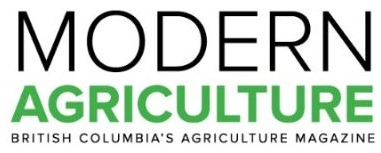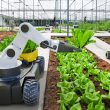Getting the most out of manure
Cate Pedersen
Farmers are responsible for the safe disposal of the manure from their animals and much of it is treated on site and redistributed on the land. The current system is expensive, time consuming, loses much of the valuable nutrients and puts a strain on the environment. With the use of anaerobic digesters, the raw manure is converted into biogas and digestate. If a dairy or hog operation uses an anaerobic digester, the farmer separates the solids out the best he can. Some of those solids are perfect for bedding in the barn which saves on shavings or sawdust and can then be put back in the digester. The rest of the smaller particulate solids will be stored for land application and the remaining liquids will be sent to a lagoon that takes up a large part of his land.
Last year in Canada, the manure from 26 million hogs had to be disposed of, and if we consider the worldwide hog industry, it is responsible for the excrement created by almost one billion hogs—over 2 billion tonnes of it.
[quote]”If you have problems with manure in terms of liquids and solids, the digester in itself does not solve those problems but it does provide a source of income that can help pay for a solution.”[/quote]
Victor Van Slyke is on a mission. A mission to help improve the way BC hog and dairy farmers treat their animal waste. His company, ATD Waste Systems Inc., designs and tests processes that interrupt the cycle of manure from barn to lagoon to land, conserving water and reducing costs to the farmer. ATD’s partnership with Bi Pure Water (Canada) Inc. in Surrey provides a way to manufacture and integrate this advanced waste and water management system into existing farming operations, and provide training and support to the on-farm operators.
Bi Pure Water utilizes living organisms to digest nutrients in waste water, and membranes to block pollutants, leaving pathogen-free water. Mike Beeney, Sales Manager at BI Pure Water would like to see all large farm operations using custom engineered treatment systems similar to those his company installs to manage their raw or digested manures.
“In Manitoba, for instance, they have regulations demanding installation of digesters if hog farmers wish to increase their herds, and in April of this year that was amended for new pilot projects by reducing nutrient limits and expanding acreage requirements—in some cases more than doubling land requirements,” he said.
Van Slyke is particularly sensitive to the problems hog farmers face. “Often, hog farmers find themselves at the bottom of the economic totem pole. They basically have no control over their feed costs or their selling price and are still responsible for manure disposal. Very often they don’t even own the hogs—because they are under contract with somebody else,” he explained. “When it comes to the additional capital expenditure of manure treatment, the hog farmer is often not prepared for it.”
[quote]“For those who are buying water or pumping out of an aquifer, they can lessen water consumption in the barn by 60 to 80 per cent.”[/quote]
Van Slyke described how hog and dairy farmers will benefit immediately from a more efficient manure disposal option with the reduction of manure volumes, odour—that ever-contentious issue for neighbouring residents—health threats, and costs associated with watering and fertilizer distribution. Taking even a portion of the liquids back to the barn reduces the volume to be distributed from the lagoon and it still holds the nutrients taken from that recycled water.
“The awful truth about the digestion business,” Slyke confided, “is that if you have problems with manure in terms of liquids and solids, the digester in itself does not solve those problems but it does provide a source of income that can help pay for a solution. After a month in the digester, what comes out is essentially what you put in. There are some physical changes. You produced some biogas and carbon dioxide, the solids are smaller, the ammonia is stronger, but the N, P and K are pretty much still there to be pumped to the lagoon and eventually applied to the land.”
The team from ATD and Bi Pure Water step in between the barn and the lagoon. What they do is take all or part of the liquid, which comprises roughly 90 per cent of the digester’s discharge, and recondition it so it can be fed back to the animals. The large fibers will be useful as bedding and smaller fibres will be stored for land application while any remaining water will be sent to the lagoon with the nutrients taken from the drinking water. The volume and the cost of spreading on the fields is greatly reduced.

“For those who are buying water or pumping out of an aquifer, they can lessen water consumption in the barn by 60 to 80 per cent. Water acquisition and disposal costs can be reduced drastically,” stated Van Slyke.
And there is money to be made in manure. “Anaerobic digestion breaks down waste in the absence of oxygen,” explained Van Slyke. “The anaerobes thrive in an enclosed space and the gases they produce can be captured and used.”
Van Slyke went on to describe the huge tank with an inflatable cover which compensates for the pressure inside and blows up like a balloon. “Basically there are two main fractions of gas produced during anaerobic digestion: Carbon dioxide and methane,” he continued. “Companies like FortisBC want the methane and will pay farmers for it, so the other components must be separated out. The biogas is indistinguishable to what a gas company would buy from the petroleum industry in terms of burning it in your oven. The Fortis people are really helping with the business of converting waste products into usable energy.” FortisBC has an option on their website so home and business owners can request that a portion of the natural gas they use is biogas.
At the moment, FortisBC will only be able to talk to farms within the vicinity of their pipeline. One interested farmer in Chilliwack is ready to proceed with a contract with the gas company because of the farm’s proximity to the pipe.
“If farmers can’t sell the gas, the alternative is to either use it on the farm or create electricity, but at this time the electricity option doesn’t seem to fly here in BC,” Van Slyke added. More people along FortisBC’s right of way could eventually be brought on board, but that will be something to look forward to down the line.
Beeney is also concerned about the missed opportunity with biofuel production and would like to see government mandates as part of Canada’s national energy program which obligates gas companies to source and harvest local renewable energy where possible before using even more fresh water to push natural gas from the ground. “If the large farms in BC could produce 10 to 15 per cent of our province’s natural gas, wouldn’t that be something to be proud of.” In the meantime, farmers who can make money selling gas will, and others can be compensated with sales of fertilizer produced from their improved manure management system.
Beeney described his vision for the future: “Ideally, there would be a fertilizer blender in each jurisdiction actually processing the nutrients from the farm into usable formats for groundskeepers, homeowners and crops. Manure nutrients are complete with trace elements missing from chemical fertilizers, and it’s a perfect replacement that supports a local farmer.”
And that just covers nutrient recovery—now there’s the task of recirculating the waste water back into use for the farmer, and that’s where BI Water Systems really adds their expertise. They are involved in the waste water treatment through to the end result—potable water. “We are in the process of finalizing our design for phase two of system. They have the nutrient recovery down and the next step is recovering even more nutrient from the digestate,” said Beeney.
“When I asked farmers how they feel about embracing new technologies and computerized systems, they tell me it is the only way they can move forward,” Beeney shared. “One farmer told me he wanted to increase his herd but he had land constraints. He could not expand his fields to feed his animals or manage the manure on his limited grounds.”
It is evident that farms cannot grow without change. “We need to have regulations in place without putting constraints on the farmer,” Beeney suggested. “And we need to move away from how we are managing manure today—broadcast spraying compromises both air and water quality and is not a very scientific way of putting nutrients back into the ground. Many municipalities are banning liquid manure spray onto fields because of the possible environmental impact. As you can imagine, the mice and birds that might get sprayed are just as susceptible to E-Coli as we are. And people have become sick from eating produce sprayed by untreated, reclaimed water.”
Van Slyke is excited to share what he has learned about waste management and water treatment with agricultural industries overseas. “Places like China where ground water might be too contaminated to pump directly from the aquifer to feed animals would benefit greatly from such technology. To be able to reduce reliance on the aquifer and eliminate the lagoon while providing clean water for their animals directly from waste matter would save money and improve animal health,” he said.
Beeney also shares Van Slyke’s vision to collaborate with other countries where water quality issues are well documented. “It is a fact that animals will drink more if it is potable. And when they drink more water they are healthier. Chicken farms here in the Fraser Valley are chlorinating water and find that the mortality rate goes down. We have actually built chlorination systems that convert salt into chlorine so that farms can produce their own chlorine economically. Cleaner water means smaller vet bills.”
When early adopters invest in waste management and water reclamation systems—and it is admittedly a huge investment—it changes the consumers’ view of agriculture and shifts the perspective of the farmer himself . . . their farms are no longer odorous, their animals are healthier and they are more able to give back to the earth what they took to produce food. Consumers also have the responsibility to make sure they are insisting on renewable energy whenever possible, placing a value on water and purchasing fertilizers produced locally.
It’s about maintaining a sustainable way of farming and using energy responsibly so that future generations benefit. Perhaps together we will make the word “waste” obsolete, and we will find ourselves—one day—wanting nothing.
For more information on waste and water systems, contact Vic Van Slyke at: 1cleanfarm@hogmanure.com or at www.dairymanure.com – contact us.
And Michael Beeney at: mikeb@bipurewater.com












